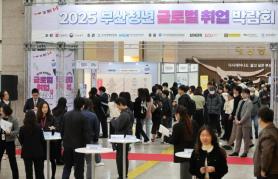
South Korea's birth rate in 2022 was 0.78 babies per couple. Data from the Bank of Korea (BOK) showed that there is a 90 percent probability that the total population could decline to below 40 million by 2070 from the current 51 million without effective government interventions. The BOK estimated a 68 percent possibility of the growth rate falling below 0 percent between 2050 and 2059.
According to the central bank's report published on December 6, competition for high-quality jobs is intensifying in South Korea, leading to a growing number of young people experiencing employment-related stress. The country's employment rate for young people aged 15 to 29 is 46.6 percent, significantly lower than the average of the Organization for Economic Cooperation and Development (OECD) OECD at 54.6 percent. The proportion of temporary workers in the country is 27.3 percent, the second highest among 34 OECD countries. Temporary workers are salaried employees whose positions have a pre-established end date.
In a 2020 survey of 2,000 South Koreans aged between 25 and 39, conducted by the BOK through pollster Gallup Korea, the average desired number of children in a group experiencing fierce competition was 0.73, while those with a relatively low sense of competition was 0.87. The inclination for marriage among employed respondents was 49.4 percent, surpassing the rates observed in both non-employed individuals (38.4 percent) and non-regular workers (36.6 percent).
The burden of expensive housing costs is also a crucial factor in the declining birth rate. The Gallup survey showed that the average number of desired children in the group with a high housing cost burden was 0.72, which was 0.1 less than the group without a high housing cost burden. In a survey of 1,000 unmarried South Koreans, 35.7 percent cited issues related to employment, stable living, and purchasing a home as reasons for remaining single.
The report indicates regions with high population density are more likely to experience low birth rates because of high competition pressure, housing prices, and non-regular employment rates. In 2022, Seoul, with a population of some 9.6 million, recorded a fertility rate of 0.59, while the central city of Sejong had 1.12. Sejong, with some 380,000 people, is regarded as the de facto administrative capital of South Korea. The city has a high proportion of public servants with high employment stability.
To mitigate childcare concerns, the bank suggested increasing the government budget against the low birth rate and establishing a work-life balance infrastructure. These include enhancing family-related government spending, extending parental leave, boosting youth employment, addressing urban population concentration, and stabilizing housing prices.
Copyright ⓒ Aju Press All rights reserved.




